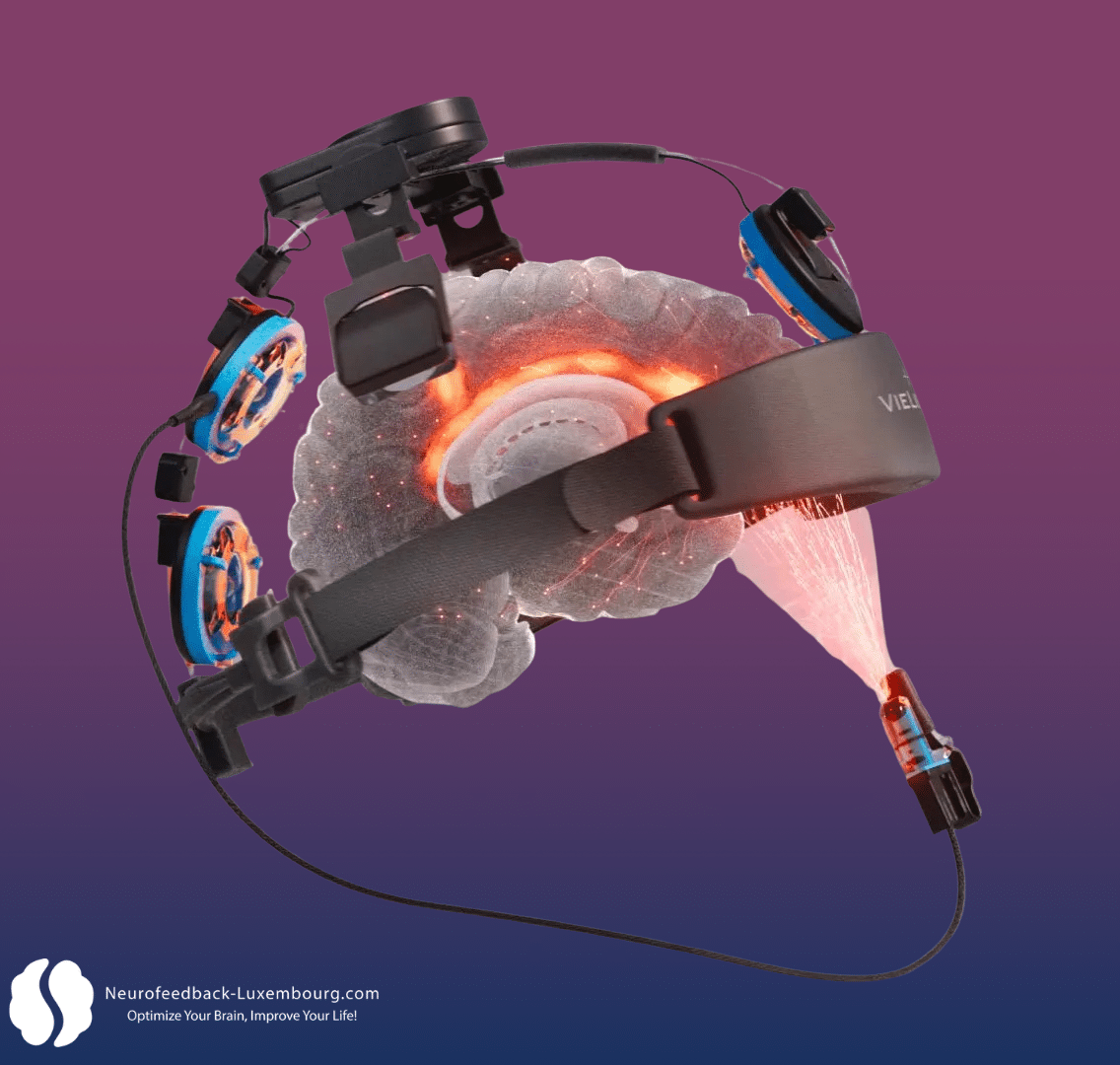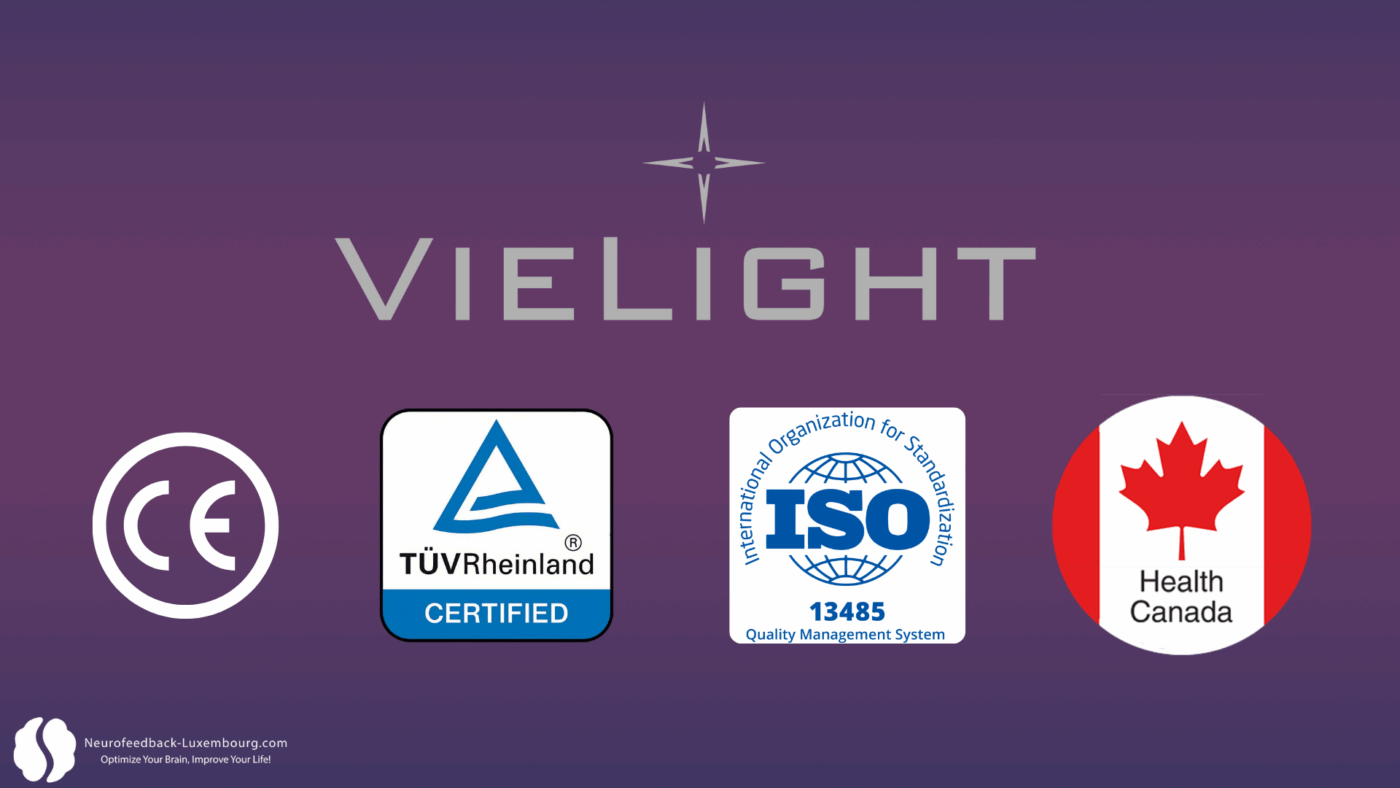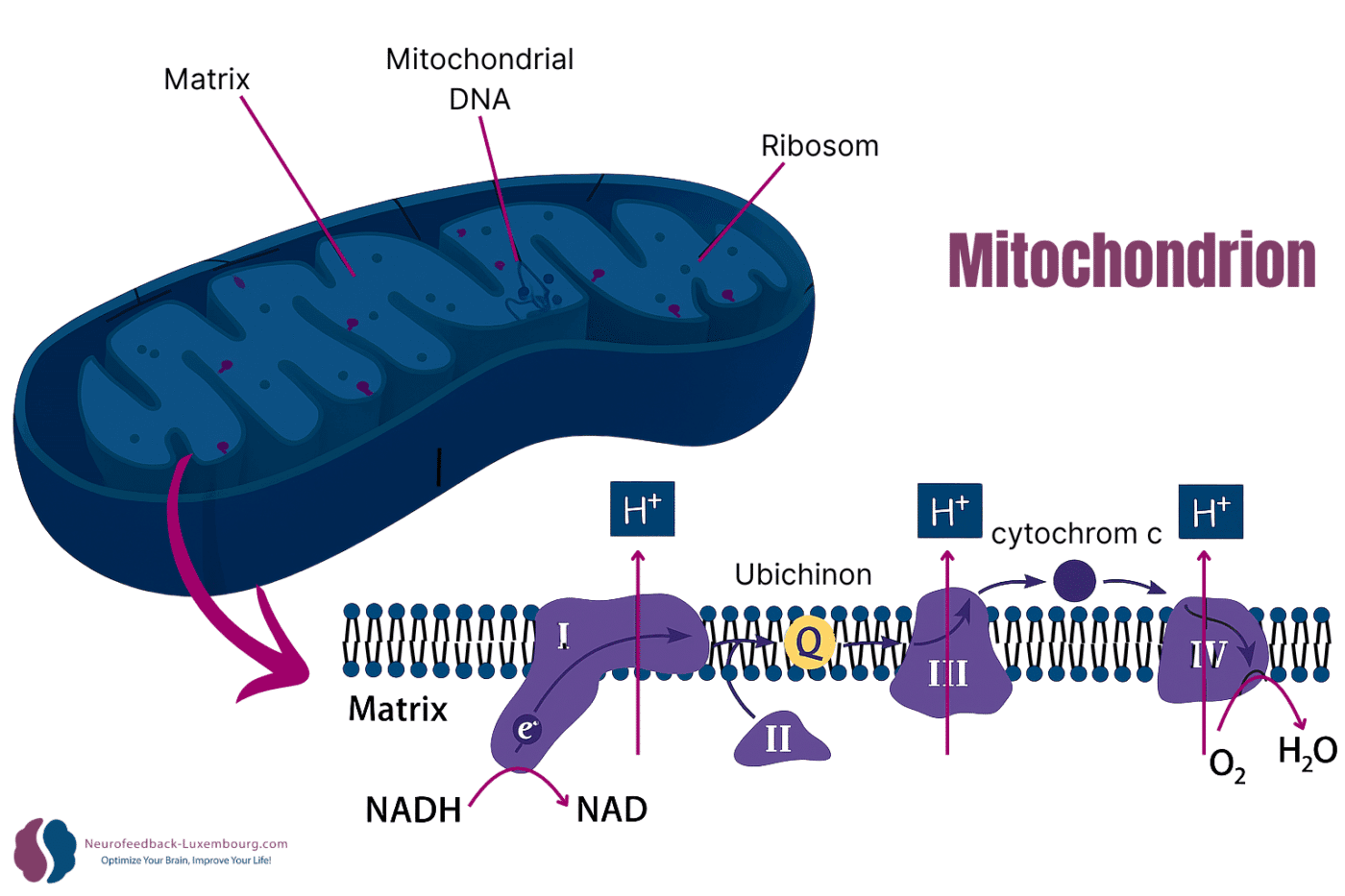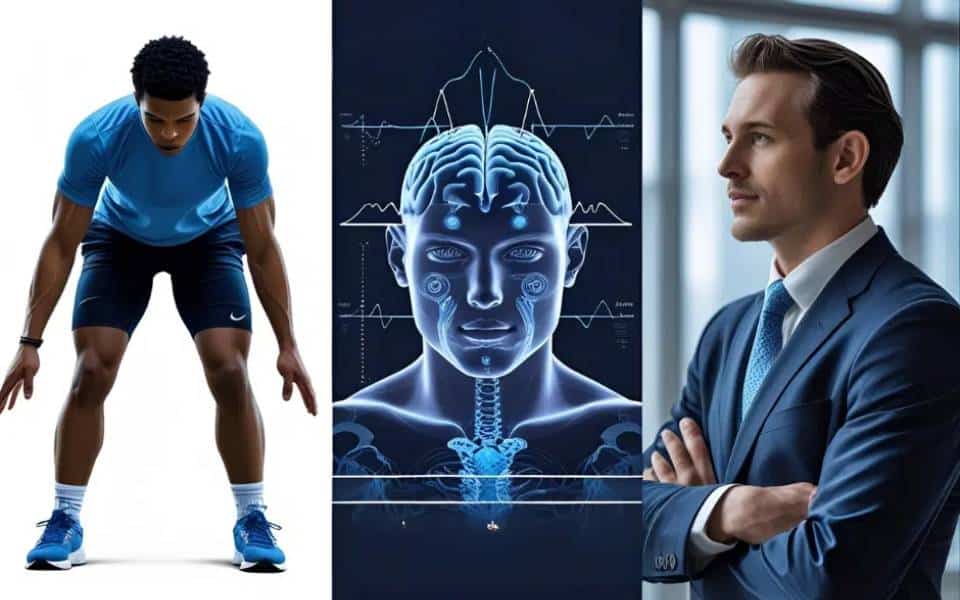Why We Chose Industry-Leading Technology

Brain photobiomodulation (PBM) is a cutting-edge, non-invasive therapy that harnesses the power of infrared light to stimulate and support the brain’s natural healing processes. By delivering near infrared energy to targeted brain regions, PBM activates cellular processes that are essential for tissue repair, regeneration, and optimal brain function. This innovative approach has been widely studied for its beneficial effects on cognitive function, memory, and mood, making it a promising therapy for a range of neurological and psychiatric disorders.
The mechanism behind brain photobiomodulation centers on the ability of infrared light to penetrate the skull and reach brain cells, where it increases blood flow, reduces inflammation, and boosts cellular energy production. These physiological effects are particularly valuable in the treatment of traumatic brain injury, degenerative diseases, and other conditions that impact brain health. Clinical research has demonstrated significant improvements in cognitive performance and overall brain function following PBM therapy, highlighting its potential to transform neurological care. As a non-invasive and safe intervention, brain photobiomodulation offers hope for those seeking to enhance brain health, support recovery, and improve quality of life.
At Neurofeedback Luxembourg, our commitment to evidence-based neurotherapy drives every technology partnership we establish. When we decided to expand our services to include cerebral photobiomodulation, choosing the right technology partner was crucial—not just for clinical efficacy, but for the scientific rigor and regulatory compliance that our clients deserve.
After extensive evaluation of the photobiomodulation landscape, we selected Vielight as our exclusive technology partner. Here’s why this partnership represents the gold standard in brain photobiomodulation technology.
Research Leadership in transcranial Photobiomodulation
The numbers speak for themselves: Vielight Neuro devices are featured in the most published clinical research in the field of brain photobiomodulation. This isn’t simply marketing hyperbole—it reflects a genuine commitment to advancing the science of light therapy for neurological applications.
The research foundation supporting Vielight technology spans multiple neurological conditions, from Alzheimer’s disease and traumatic brain injury to cognitive enhancement and brain health optimization. Alzheimer’s disease is a primary focus of research, with PBM showing promise in improving cognitive functions and slowing disease progression in Alzheimer’s disease patients through mechanisms such as enhanced mitochondrial activity, neuroprotection, and increased cerebral blood flow. Recent systematic reviews consistently reference Vielight devices in clinical studies, aggregating and evaluating multiple studies to help standardize protocols and assess the safety and efficacy of laser and LED therapies in neurological conditions, establishing them as the de facto research standard in the field. Clinical studies have reported positive results in various neurological conditions, including improvements in cognitive function and reductions in neuroinflammation.
This research leadership directly benefits our clients. When we implement a Vielight protocol, we’re not experimenting—we’re applying methodologies that have been validated in peer-reviewed studies and replicated across multiple research institutions and clinics.
Regulatory Excellence and Safety Credentials

CE Marking and European Compliance: Vielight devices carry proper CE marking, demonstrating compliance with European Medical Device Regulation (MDR) requirements. This certification process involves rigorous safety testing and quality management system verification—essential for professional clinical applications.
TÜV Rheinland Certification: All Vielight devices have undergone independent TÜV certification, confirming their electrical safety and adherence to international standards. This third-party validation provides an additional layer of confidence in device reliability and patient safety.
ISO 13485 Quality Management: Vielight maintains ISO 13485 certification, the international standard for quality management systems in medical device manufacturing. This ensures consistent manufacturing processes and quality control throughout the production lifecycle.
Health Canada Approval: Vielight devices have received Health Canada approval for specific applications, including COVID-19 recovery protocols, demonstrating regulatory acceptance in a stringent healthcare environment.
Technical Specifications: The Science Behind the Technology
Optimized 810nm NIR Wavelength
Vielight’s selection of 810nm near-infrared (NIR) wavelength isn’t arbitrary—it’s based on extensive research into optimal photobiomodulation parameters. This wavelength offers several critical advantages:
- Optimal tissue penetration: Cadaver studies demonstrate that 810nm NIR light can penetrate approximately 40mm into brain tissue (1), sufficient to reach cortical structures. While red light is also used in transcranial photobiomodulation, its penetration depth is less than that of 810nm near-infrared, making NIR more effective for targeting deeper brain regions. The 810nm wavelength interacts with various head tissues—including skin, skull, and brain structures—allowing for effective light delivery through these layers to reach the intended treatment depth.
- Mitochondrial targeting: 810nm wavelength effectively stimulates cytochrome c oxidase (2), the key enzyme in cellular energy production
Industry-Leading Power Density
The Vielight Neuro 4 delivers 100-300 mW/cm² power density—a carefully calibrated range that provides therapeutic benefits without thermal damage. This power density range:
- Exceeds the minimum threshold for biological effect
- Remains well below levels that could cause cellular damage
- Allows for flexible protocol adaptation based on individual needs
Patented Transcranial-Intranasal Design
Vielight’s unique approach combines transcranial and intranasal delivery methods in a single device:
Transcranial Components: Target specific brain networks through strategically positioned LEDs that can be adjusted to focus on areas of interest—from default mode network nodes to motor cortex regions. Some systems use a LED helmet as a specific device to deliver focused light stimulation to the scalp.
Intranasal Component: Leverages the rich vascular network of the nasal cavity for systemic effects and direct access to brain structures via the olfactory pathway. Intranasal LED devices are designed to deliver light directly to the nasal cavity for targeted brain therapy.
This dual-delivery approach maximizes therapeutic potential while ensuring comprehensive brain coverage. The system effectively combines two devices or components—transcranial and intranasal—for comprehensive brain coverage and enhanced therapeutic outcomes.
Precise Frequency Modulation
The Neuro 4allows for adjustment of pulse rates to match specific brainwave frequencies, offering both Alpha (10Hz) and Gamma (40Hz) frequency modes for targeted neural oscillation entrainment:
- Alpha (10Hz): Associated with relaxation, creative states, and general brain health optimization. The Neuro Alpha device is designed to deliver stimulation at this alpha frequency, promoting mental calmness and flow states.
- Gamma (40Hz): Linked to cognitive performance, focus, and specific therapeutic effects in neurodegenerative conditions. The Neuro Gamma device delivers gamma frequency stimulation, supporting enhanced focus, memory, and mental energization.
This adjustable frequency precision allows us to customize protocols based on individual QEEG findings and therapeutic objectives.
Light Penetration and Absorption
One of the most critical factors in the effectiveness of transcranial photobiomodulation is the ability of light to penetrate the various layers of the head and reach targeted brain regions. Near infrared light, particularly in the 700-1100 nm wavelength range, is uniquely suited for this purpose. Unlike visible light, which is largely absorbed or scattered by superficial tissues, near infrared light can penetrate deeper into the brain, allowing for direct stimulation of neurons and neural networks involved in cognitive function.

This enhanced light penetration is essential for activating key cellular processes within the brain. At the cellular level, cytochrome c oxidase—a vital enzyme in the mitochondrial respiratory chain (3)—acts as a primary chromophore, absorbing the delivered energy from the light source. This absorption triggers a cascade of biological activity, including increased ATP production, improved cellular metabolism, and reduced oxidative stress. As a result, the targeted brain regions receive a boost in energy, supporting neural regeneration and optimizing cognitive performance. These effects are not limited to the brain; photobiomodulation also benefits the human body as a whole by improving blood flow, reducing inflammation, and supporting overall physiological health.
The precise selection of wavelengths and stimulation parameters ensures that the energy delivered is both safe and effective, maximizing the therapeutic benefits of photobiomodulation while minimizing the risk of tissue damage. By leveraging the superior tissue penetration of near infrared light, devices like Vielight are able to deliver meaningful physiological effects deep within the brain, supporting a wide range of clinical applications from cognitive enhancement to the management of degenerative diseases.
Cellular Activity and Health
Transcranial photobiomodulation exerts its beneficial effects by directly influencing cellular activity and promoting overall brain health. When near-infrared light is absorbed by brain cells, it stimulates a series of fundamental cellular processes that support tissue healing and optimization. Photobiomodulation has also been widely used for wound healing, highlighting its role in tissue repair processes beyond the brain. This includes enhanced mitochondrial function, improved cerebral blood flow, reduced neuroinflammation, and the promotion of cellular repair mechanisms that create an optimal environment for brain function and neural network connectivity.
These cellular effects translate into significant improvements in cognitive function, particularly for individuals affected by degenerative diseases such as Alzheimer’s disease. By supporting mitochondrial function and reducing oxidative stress, photobiomodulation helps preserve neuronal integrity and slow the progression of neurodegeneration. Furthermore, the therapy’s ability to modulate blood flow and reduce inflammation contributes to its neuroprotective properties.
Beyond its impact on neurodegenerative conditions, low level light therapy has demonstrated beneficial effects in the treatment of psychiatric disorders, including depression, anxiety, and post traumatic stress disorder (PTSD). Clinical research has shown that near infrared light can help regulate mood, alleviate symptoms of stress, and support emotional well-being, all with minimal negative side effects. This makes photobiomodulation a safe, non-invasive, and versatile therapy for a broad spectrum of neurological and psychiatric conditions, offering hope for improved quality of life and cognitive resilience.
Integration with Evidence-Based Practice
Our partnership with Vielight aligns perfectly with our commitment to QEEG-guided, evidence-based neurotherapy. The ability to combine photobiomodulation with neurofeedback creates synergistic effects that enhance overall treatment outcomes.
Clinical Research Foundation: The extensive research literature supporting Vielight devices provides the scientific rationale for specific protocols and treatment approaches, enabling us to make evidence-based decisions about parameter selection and treatment timing.
Standardized Protocols: The consistency of Vielight technology across research studies allows us to implement protocols that have been validated in clinical settings, reducing variability and improving predictability of outcomes.
Professional-Grade Reliability
For a clinical practice, device reliability isn’t optional—it’s essential. Vielight’s track record includes:
- Consistent manufacturing quality backed by ISO certification
- Robust device construction suitable for daily clinical use
- Comprehensive safety protocols and contraindication guidelines
- Ongoing technical support and protocol guidance
The Future of Neurotechnology
Our partnership with Vielight positions Neurofeedback Luxembourg at the forefront of neurotechnology integration. Advances in brain stimulation technologies, including photobiomodulation, are shaping the future of neurotherapy. As research continues to expand our understanding of photobiomodulation mechanisms and optimal parameters, we’re equipped with a technology platform that can evolve with the science.
The combination of rigorous research validation, regulatory compliance, and technical excellence makes Vielight the clear choice for serious practitioners committed to evidence-based neurotherapy.
Research Applications: A Comprehensive Evidence Base
The depth of Vielight’s research portfolio extends across multiple neurological and cognitive domains, demonstrating the versatility and scientific rigor behind our technology choice. In transcranial photobiomodulation research for neurological conditions such as Parkinson’s disease, Alzheimer’s disease, TBI, and depression, protocols and device features like rasta sh have been referenced for their role in stimulating neural activity and improving brain function. Research has also explored the effects of photobiomodulation on memory and related cognitive functions. Here’s an overview of key research applications using Vielight devices:

Neurodegenerative Diseases
Alzheimer’s Disease and Dementia: Multiple studies have demonstrated Vielight’s potential in treating cognitive decline. Saltmarche et al. (4) reported significant improvement in cognition in mild to moderately severe dementia cases treated with transcranial plus intranasal photobiomodulation using Vielight devices. The study showed significant improvements in both MMSE and ADAS-cog scores after 12 weeks of treatment.
A recent pilot study by Rashidi-Ranjbar et al. (5) investigating mild cognitive impairment (MCI) found significant improvements in executive function, neuronal health, and functional connectivity using the Vielight Neuro RX Gamma device. Notably, the study demonstrated decreased AD markers and improved mitochondrial function markers in blood samples.
Parkinson’s Disease: Liebert et al. (6) conducted a prospective proof-of-concept study showing improvements in clinical signs of Parkinson’s disease using photobiomodulation. The study reported significant improvements in mobility, cognition, dynamic balance, and fine motor skills that were maintained for up to one year with sustained home treatment.
Traumatic Brain Injury and Concussion
Professional Athletes: Chao et al. (7) documented remarkable improvements in a professional hockey player with concussion history. After 8 weeks of home treatment with Vielight devices, the study observed increased brain volumes, improved functional connectivity, increased cerebral perfusion, and improvements in neuropsychological test scores.
Chronic Traumatic Encephalopathy: Naeser et al. (8) treated four ex-football players with possible chronic traumatic encephalopathy using Vielight devices. The study showed significant improvements in neuropsychological tests, reduced PTSD and depression scores, improved sleep quality, and correlations between increased functional connectivity and cognitive improvements.
Neuromuscular Control: A recent study by Johnson et al. (2) investigated 43 participants with repetitive head acceleration events, demonstrating significant improvements in reaction time, balance control, and bilateral grip strength after 8 weeks of intranasal plus transcranial photobiomodulation treatment.
Psychiatric and Developmental Conditions
Autism Spectrum Disorders: Pallanti et al. (9) conducted a retrospective study with 21 children with ASD, showing significant reductions in autism severity scores, noncompliant behavior, parental stress, and improvements in attention and sleep quality after 6 months of transcranial photobiomodulation.
Gulf War Illness: Chao (10) reported the first documentation of improved Gulf War Illness symptoms in veterans following 12 weeks of PBM treatments, demonstrating the potential for addressing complex, multi-system disorders.
Clinical trials have also investigated the use of photobiomodulation for generalized anxiety disorder, with promising preliminary results suggesting potential benefits in alleviating symptoms associated with this condition.
Cognitive Enhancement and Performance
Creative Thinking: Peña et al. (11) demonstrated that transcranial photobiomodulation over the default mode network significantly enhanced divergent creative thinking in healthy participants, showing specific effects on creativity without affecting convergent thinking.
Neural Oscillations: Zomorrodi et al. (12) provided groundbreaking evidence that a single session of Vielight photobiomodulation significantly modulates neural oscillations, increasing higher frequency power (alpha, beta, gamma) while reducing lower frequency activity (delta, theta).
Infectious Disease Recovery
COVID-19: Lim et al. (13) conducted a randomized controlled trial showing that patients with ≤7 days of COVID-19 symptoms recovered significantly faster with Vielight photobiomodulation therapy compared to standard care, with a median recovery time of 18 days versus 21 days.
A pilot study (NCT05857124) is currently investigating the efficacy of the Vielight Neuro RX Gamma in treating post-COVID cognitive impairment, addressing the growing concern of long COVID neurological symptoms.
Mechanistic Research
Cellular and Molecular Level: Staelens et al. (14) investigated the effects of photobiomodulation on living cells, tubulin, and microtubules, providing crucial insights into the cellular mechanisms underlying PBM’s therapeutic effects. The study revealed specific effects on protein structures and microtubule stability.
Protein Structure Analysis: Di Gregorio et al. (15) used Raman spectroscopy to reveal photobiomodulation-induced α-helix to β-sheet transitions in tubulins, providing novel mechanistic insights into how PBM might address neurodegenerative diseases by affecting protein conformations.
Clinical Trial Infrastructure
Methodological Validation: Multiple studies have established standardized protocols for Vielight device usage, creating a robust foundation for future research. The consistency in parameters (810nm wavelength, specific power densities, treatment durations) across studies enables reliable replication and meta-analysis.
Home Treatment Protocols: Several studies have validated the effectiveness of home-based treatment protocols, demonstrating that Vielight technology can be safely and effectively administered outside clinical settings while maintaining therapeutic benefits.
This extensive research portfolio demonstrates why Vielight represents the most scientifically validated approach to brain photobiomodulation. The diversity of applications—from neurodegenerative diseases to cognitive enhancement—combined with consistent positive outcomes across multiple independent research groups, provides compelling evidence for the technology’s therapeutic potential.
The research speaks for itself: when we chose Vielight as our technology partner, we weren’t just selecting a device manufacturer—we were aligning with the most evidence-based approach to photobiomodulation therapy available today.
Treatment Outcomes
The therapeutic outcomes of brain photobiomodulation are both diverse and promising, with numerous studies reporting significant improvements across a range of neurological and psychiatric conditions. Individuals undergoing PBM therapy have experienced enhanced cognitive function, better memory retention, and improved mood. For patients recovering from traumatic brain injury, PBM has been associated with accelerated cognitive recovery and greater overall brain resilience.
Beyond injury recovery, brain photobiomodulation has shown positive results in managing symptoms of generalized anxiety disorder, attention deficit hyperactivity disorder (ADHD), and post traumatic stress disorder (PTSD). Many users also report improvements in sleep quality, reduced stress, and a greater sense of relaxation following regular therapy sessions. In the context of degenerative diseases such as Alzheimer’s, PBM has contributed to meaningful gains in cognitive performance and daily functioning.
While individual responses may vary depending on the device, protocol, and underlying condition, the consistent theme across research is the potential for significant improvements in brain health and quality of life. As more research emerges, the evidence base for brain photobiomodulation continues to grow, reinforcing its role as a valuable tool in modern neurotherapy.
Experience Vielight: Test next-generation brain optimization
Ready to experience the next generation of brain optimization? Our Vielight photobiomodulation protocols are now available as part of our comprehensive neurotherapy services. Contact us to learn how this cutting-edge technology can enhance your cognitive performance and brain health.
Schedule your consultation today and discover why we chose the most researched technology in brain photobiomodulation.
User Experience and Feedback
The real-world impact of photobiomodulation devices is best reflected in the experiences of users who have incorporated this technology into their daily lives. Individuals using LED helmets and other PBM devices consistently report significant improvements in cognitive function, sleep quality, and overall well-being. Many users describe enhanced mental clarity, increased energy, and improved focus—benefits that are especially valuable for those managing attention deficit hyperactivity disorder (ADHD) or recovering from traumatic brain injury.
Feedback from users also highlights notable improvements in mood, with reductions in anxiety and depression symptoms frequently reported. For individuals living with degenerative diseases or psychiatric disorders, these positive changes can represent a transformative shift in daily functioning and emotional health. Enhanced motor performance, better sleep patterns, and reduced stress levels are additional benefits that contribute to a higher quality of life.
As clinical research continues to validate these outcomes, the adoption of photobiomodulation devices is expanding across diverse populations. The overwhelmingly positive user experience, combined with the growing body of scientific evidence, underscores the potential of PBM as a powerful tool for brain health optimization, cognitive enhancement, and the management of complex neurological and psychiatric conditions. With ongoing advancements in device technology and protocol development, photobiomodulation is poised to become an integral part of modern neurotherapy and wellness strategies.
Expertise and Support
Achieving the best possible outcomes with brain photobiomodulation therapy relies on the guidance and support of experienced professionals. Clinicians, researchers, and device manufacturers play a vital role in helping individuals navigate the complexities of PBM technology and tailor treatment plans to their unique needs. Companies like Vielight offer complimentary consultations and expert advice, ensuring that users select the most appropriate device and protocol for their goals.
Final Thoughts
Brain photobiomodulation represents a revolutionary advancement in the field of neurological therapy, offering a safe and effective way to enhance cognitive function, memory, and overall brain health. By utilizing the power of infrared light, PBM stimulates essential cellular processes, promotes tissue healing, and delivers significant improvements for a wide range of conditions. With a variety of devices available—each designed to meet specific therapeutic needs—individuals can find the right solution to support their brain health journey.
While ongoing research is essential to fully understand the long-term benefits and optimal applications of photobiomodulation, the current evidence is highly encouraging. Users and clinicians alike are witnessing meaningful improvements in cognitive performance, mood, and quality of life. As the field continues to evolve, staying informed and working with experienced professionals will be key to unlocking the full potential of light therapy. By embracing this innovative approach, individuals can experience firsthand the transformative power of brain photobiomodulation and take proactive steps toward a healthier, more vibrant life.
References
(1) Saltmarche, A. E., Naeser, M. A., Ho, K. F., Hamblin, M. R., & Lim, L. (2017). Significant Improvement in Cognition in Mild to Moderately Severe Dementia Cases Treated with Transcranial Plus Intranasal Photobiomodulation : Case Series Report. Photomedicine and Laser Surgery, 35(8), 432‑441. https://doi.org/10.1089/pho.2016.4227
(2) Johnson, P. K., Fino, P. C., Wilde, E. A., Hovenden, E. S., Russell, H. A., Velez, C., Pelo, R., Morris, A. J., Kreter, N., Read, E. N., Keleher, F., Esopenko, C., Lindsey, H. M., Newsome, M. R., Thayn, D., McCabe, C., Mullen, C. M., Davidson, L. E., Liebel, S. W., … Tate, D. F. (2024). The Effect of Intranasal Plus Transcranial Photobiomodulation on Neuromuscular Control in Individuals with Repetitive Head Acceleration Events. Photobiomodulation, Photomedicine, and Laser Surgery, 42(6), 404‑413. https://doi.org/10.1089/pho.2023.0178
(3) Salehpour, F., Mahmoudi, J., Kamari, F., Sadigh-Eteghad, S., Rasta, S. H., & Hamblin, M. R. (2018). Brain Photobiomodulation Therapy : A Narrative Review. Molecular Neurobiology, 55(8), 6601‑6636. https://doi.org/10.1007/s12035-017-0852-4
(4) Saltmarche, A. E., Naeser, M. A., Ho, K. F., Hamblin, M. R., & Lim, L. (2017). Significant Improvement in Cognition in Mild to Moderately Severe Dementia Cases Treated with Transcranial Plus Intranasal Photobiomodulation : Case Series Report. Photomedicine and Laser Surgery, 35(8), 432‑441. https://doi.org/10.1089/pho.2016.4227
(5) Rashidi‐Ranjbar, N., Churchill, N. W., Graham, S. J., Schneider, R., Rajji, T. K., Andreazza, A. C., Lim, L., Coull, J., Munoz, D. G., Fornazzari, L. R., Schweizer, T. A., & Fischer, C. E. (2025). A pilot study evaluating the feasibility, safety, and efficacy of transcranial photobiomodulation (tPBM) for the treatment of mild cognitive impairment (MCI) : Preliminary findings. Alzheimer’s & Dementia, 20(Suppl 8), e095049. https://doi.org/10.1002/alz.095049
(6) Liebert, A., Bicknell, B., Laakso, E.-L., Heller, G., Jalilitabaei, P., Tilley, S., Mitrofanis, J., & Kiat, H. (2021). Improvements in clinical signs of Parkinson’s disease using photobiomodulation : A prospective proof-of-concept study. BMC Neurology, 21(1), 256. https://doi.org/10.1186/s12883-021-02248-y
(7) Chao, L. L., Barlow, C., Karimpoor, M., & Lim, L. (2020). Changes in Brain Function and Structure After Self-Administered Home Photobiomodulation Treatment in a Concussion Case. Frontiers in Neurology, 11. https://doi.org/10.3389/fneur.2020.00952
(8) Naeser, M. A., Martin, P. I., Ho, M. D., Krengel, M. H., Bogdanova, Y., Knight, J. A., Hamblin, M. R., Fedoruk, A. E., Poole, L. G., Cheng, C., & Koo, B. (s. d.). Transcranial Photobiomodulation Treatment : Significant Improvements in Four Ex-Football Players with Possible Chronic Traumatic Encephalopathy. Journal of Alzheimer’s Disease Reports, 7(1), 77‑105. https://doi.org/10.3233/ADR-220022
(9) Pallanti, S., Di Ponzio, M., Grassi, E., Vannini, G., & Cauli, G. (2022). Transcranial Photobiomodulation for the Treatment of Children with Autism Spectrum Disorder (ASD) : A Retrospective Study. Children, 9(5), Article 5. https://doi.org/10.3390/children9050755
(10) Chao, L. L. (2019). Effects of Home Photobiomodulation Treatments on Cognitive and Behavioral Function, Cerebral Perfusion, and Resting-State Functional Connectivity in Patients with Dementia : A Pilot Trial. Photobiomodulation, Photomedicine, and Laser Surgery, 37(3), 133‑141. https://doi.org/10.1089/photob.2018.4555
(11) Peña, J., Muthalib, M., Beaty, R. E., Sampedro, A., Ibarretxe-Bilbao, N., Zubiaurre-Elorza, L., García-Guerrero, M. A., Cortazar, I., Niso, M., & Ojeda, N. (2024). Enhancement of Divergent Creative Thinking After Transcranial Near-Infrared Photobiomodulation Over the Default Mode Network. Creativity Research Journal, 36(1), 1‑14. https://doi.org/10.1080/10400419.2023.2219953
(12) Zomorrodi, R., Loheswaran, G., Pushparaj, A., & Lim, L. (2019). Pulsed Near Infrared Transcranial and Intranasal Photobiomodulation Significantly Modulates Neural Oscillations : A pilot exploratory study. Scientific Reports, 9(1), 1‑11. https://doi.org/10.1038/s41598-019-42693-x
(13) Lim, L., Hosseinkhah, N., Van Buskirk, M., Berk, A., Loheswaran, G., Abbaspour, Z., Karimpoor, M., Smith, A., Ho, K. F., Pushparaj, A., Zahavi, M., White, A., Rubine, J., Zidel, B., Henderson, C., Clayton, R. G., Tingley, D. R., Miller, D. J., Karimpoor, M., & Hamblin, M. R. (2024). Photobiomodulation Treatment with a Home-Use Device for COVID-19 : A Randomized Controlled Trial for Efficacy and Safety. Photobiomodulation, Photomedicine, and Laser Surgery, 42(6), 393‑403. https://doi.org/10.1089/pho.2023.0179
(14) Staelens, M., Di Gregorio, E., Kalra, A. P., Le, H. T., Hosseinkhah, N., Karimpoor, M., Lim, L., & Tuszyński, J. A. (2022). Near-Infrared Photobiomodulation of Living Cells, Tubulin, and Microtubules In Vitro. Frontiers in Medical Technology, 4. https://doi.org/10.3389/fmedt.2022.871196
(15) Di Gregorio, E., Staelens, M., Hosseinkhah, N., Karimpoor, M., Liburd, J., Lim, L., Shankar, K., & Tuszyński, J. A. (2024). Raman Spectroscopy Reveals Photobiomodulation-Induced α-Helix to β-Sheet Transition in Tubulins : Potential Implications for Alzheimer’s and Other Neurodegenerative Diseases. Nanomaterials, 14(13), Article 13. https://doi.org/10.3390/nano14131093

